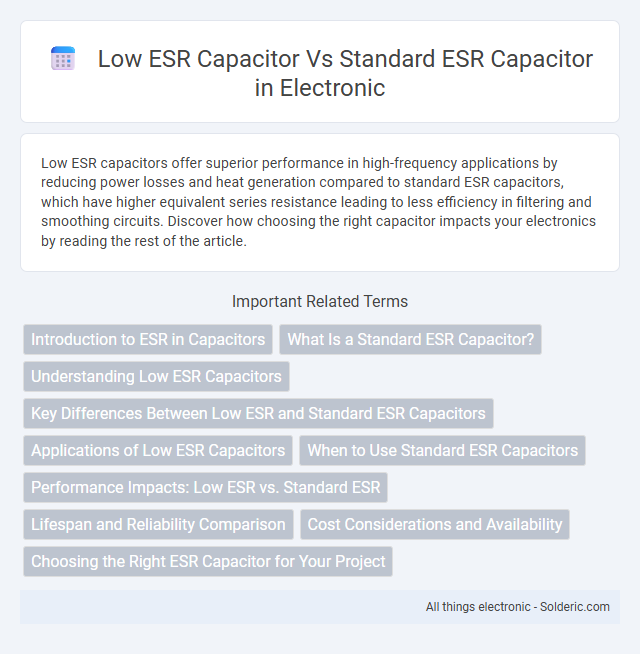Low ESR capacitors offer superior performance in high-frequency applications by reducing power losses and heat generation compared to standard ESR capacitors, which have higher equivalent series resistance leading to less efficiency in filtering and smoothing circuits. Discover how choosing the right capacitor impacts your electronics by reading the rest of the article.
Comparison Table
| Feature | Low ESR Capacitor | Standard ESR Capacitor |
|---|---|---|
| Equivalent Series Resistance (ESR) | Very low, typically < 0.01 O | Higher, typically 0.05 - 0.5 O |
| Applications | Switching power supplies, high-frequency circuits, low ripple applications | General purpose, low frequency, power filtering |
| Heat Generation | Minimal, improves efficiency | Higher, more heat dissipation |
| Frequency Response | Optimized for high-frequency stability | Limited high-frequency performance |
| Cost | Higher price due to advanced materials and construction | Lower cost, widely available |
| Lifespan | Longer lifespan under high-frequency stress | Shorter lifespan in demanding applications |
Introduction to ESR in Capacitors
Equivalent Series Resistance (ESR) in capacitors determines their efficiency in filtering and energy storage applications, as it represents the internal resistance that dissipates power as heat. Low ESR capacitors feature significantly reduced resistance values compared to standard ESR capacitors, enabling better performance in high-frequency circuits and improved thermal management. Your choice of capacitor affects circuit stability and longevity, especially in power supply and audio applications where low ESR is critical.
What Is a Standard ESR Capacitor?
A standard ESR capacitor features an Equivalent Series Resistance (ESR) value typical to most traditional capacitors, influencing its overall efficiency and heat generation in circuits. These capacitors are suitable for general electronic applications but may cause increased power losses and reduced performance in high-frequency or high-current environments. Your choice between standard and low ESR capacitors depends on the required noise reduction, lifespan, and stability of your electronic device.
Understanding Low ESR Capacitors
Low ESR capacitors feature significantly lower equivalent series resistance compared to standard ESR capacitors, resulting in improved efficiency and reduced heat generation in high-frequency applications. These capacitors are essential for smoothing voltage fluctuations and minimizing ripple in power supplies, making them ideal for demanding electronic circuits and devices. Your choice of a low ESR capacitor ensures enhanced reliability and longer lifespan in environments requiring fast switching and stable performance.
Key Differences Between Low ESR and Standard ESR Capacitors
Low ESR capacitors feature significantly lower equivalent series resistance compared to standard ESR capacitors, resulting in better performance in high-frequency and high-ripple current applications. Standard ESR capacitors typically have higher resistance, which leads to increased heat generation and reduced efficiency under heavy load conditions. Low ESR capacitors are essential in power supply circuits and fast switching environments where minimizing energy loss and heat is critical.
Applications of Low ESR Capacitors
Low ESR capacitors are essential in high-frequency switching power supplies, DC-DC converters, and automotive electronics where rapid charge-discharge cycles necessitate minimal internal resistance for efficiency and heat reduction. Their superior performance in reducing voltage ripple and electromagnetic interference makes them ideal for use in telecommunications and computer motherboards. Standard ESR capacitors, while suitable for general-purpose filtering and decoupling, may not meet the stringent demands of high-current, high-frequency applications that require low equivalent series resistance.
When to Use Standard ESR Capacitors
Standard ESR capacitors are suitable for applications with low-frequency signals or where cost efficiency is a priority, such as general-purpose power supply filtering and decoupling. These capacitors perform adequately in circuits without high ripple currents or fast transient responses, making them ideal for typical electronic devices. Your choice of standard ESR capacitors ensures reliable operation in non-demanding environments without the need for specialized low ESR performance.
Performance Impacts: Low ESR vs. Standard ESR
Low ESR capacitors deliver superior performance in high-frequency and high-current applications by minimizing energy loss and heat generation, enhancing overall circuit efficiency and reliability. Standard ESR capacitors, with higher equivalent series resistance, often cause increased ripple voltage and reduced lifespan under demanding conditions. Selecting low ESR capacitors improves transient response and reduces signal distortion, critical in power supply filters and audio circuits.
Lifespan and Reliability Comparison
Low ESR capacitors exhibit significantly longer lifespan and enhanced reliability compared to standard ESR capacitors due to reduced internal heat generation and improved efficiency in high-frequency applications. The lower equivalent series resistance minimizes energy loss and thermal stress, which directly contributes to the capacitor's durability under continuous electrical load and harsh operating conditions. This reliability advantage makes low ESR capacitors ideal for critical electronic systems requiring stable performance over extended periods.
Cost Considerations and Availability
Low ESR capacitors generally come at a higher cost compared to standard ESR capacitors due to their advanced materials and manufacturing processes designed to reduce Equivalent Series Resistance. Their availability can be more limited, especially in high capacitance and voltage ratings, as they are often sourced from specialized suppliers for applications requiring high performance and reliability. Standard ESR capacitors are widely available and more cost-effective, making them suitable for general-purpose applications where low resistance is not critical.
Choosing the Right ESR Capacitor for Your Project
Choosing the right ESR capacitor depends on your circuit's frequency and stability requirements, where low ESR capacitors excel in applications demanding minimal equivalent series resistance for improved ripple current handling and reduced heat generation. Low ESR capacitors are ideal for switching power supplies, high-frequency circuits, and high-current applications, whereas standard ESR capacitors suit less critical applications with lower ripple currents and simpler filtering needs. Evaluating parameters like ripple current rating, lifetime, and thermal performance helps ensure optimal capacitor selection tailored to specific electrical and thermal demands.
low ESR capacitor vs standard ESR capacitor Infographic

 solderic.com
solderic.com